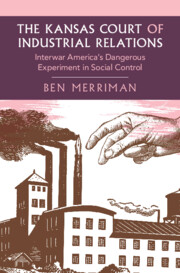Refine search
Actions for selected content:
5 results
7 - The KCIR before the US Supreme Court
- from Part II - The KCIR in the World
-
- Book:
- The Kansas Court of Industrial Relations
- Published online:
- 26 July 2025
- Print publication:
- 14 August 2025, pp 178-196
-
- Chapter
- Export citation
8 - Locking into Liberalism
- from Part II - The KCIR in the World
-
- Book:
- The Kansas Court of Industrial Relations
- Published online:
- 26 July 2025
- Print publication:
- 14 August 2025, pp 197-217
-
- Chapter
- Export citation
1 - The Court That Failed
-
- Book:
- The Kansas Court of Industrial Relations
- Published online:
- 26 July 2025
- Print publication:
- 14 August 2025, pp 1-32
-
- Chapter
-
- You have access
- HTML
- Export citation

The Kansas Court of Industrial Relations
- Interwar America's Dangerous Experiment in Social Control
-
- Published online:
- 26 July 2025
- Print publication:
- 14 August 2025
29 - Labour Law
- from VI - Social Ordering
-
-
- Book:
- The Cambridge Legal History of Australia
- Published online:
- 04 August 2022
- Print publication:
- 18 August 2022, pp 671-692
-
- Chapter
- Export citation
